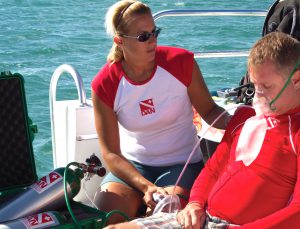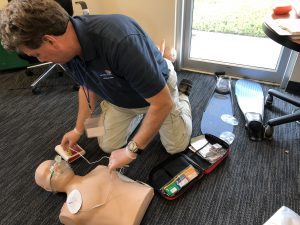I’m sure that we have all heard the saying, “An ounce of prevention is worth a pound of cure.” As divers, we plan our dives, then dive our plan. But have we planned what we will do when (not if) an emergency happens? While by its very nature, responding to an emergency situation is reactionary and incident-specific, how we respond to a given situation can indeed be planned. The question then becomes, how do we plan for emergencies?
Let’s define what an emergency is. An emergency, according to dictionary.com is:
- sudden, urgent, usually unexpected occurrence or occasion requiring immediate action.
- a state, especially of need for help or relief, created by some unexpected event.
Most dive instructors, and the well-prepared diver, have a “save-a-dive” kit. In that kit are various pieces, parts and tools needed to make minor field repairs to scuba gear. This is typically O-rings, mask or fin straps, spare batteries for dive computers or lights, perhaps even an extra inflator hose. Certainly, an O-ring failure while gearing up for that epic dive of a lifetime could constitute a sudden, urgent and unexpected occurrence that requires immediate action. And we are prepared for it.
But are we prepared for other emergencies? Do we have a first-aid kit handy? How about an oxygen kit? An AED? Are they properly stocked and stowed? Do we know how to use them? Are our first-aid provider skills up-to-date? Where is the nearest hospital? Where is the nearest chamber? How do we activate EMS? Are there other resources available? Are our in-water rescue skills up to snuff? And here is the biggest question: Have we practiced these skills lately?
Just as proper dive planning is needed for a successful dive, so is a proper emergency plan. This emergency plan starts long before we reach the dive site or boat. Do you have a written emergency action plan in place? A written emergency action plan that is properly executed can help your defense in the event of an accident or incident and any subsequent litigation that may arise.
What goes into that plan? This is a multistep process, and it starts long before any dive is conducted.
Step 1: Assess your needs
Take a good hard look at what you will need. Try to anticipate, as much as you can, any possible emergency. This could be small emergencies, such as a blown O-ring or broken mask strap. It could be as large as an out-of-control ascent by a diver that results in an arterial gas embolism or fatality. Maybe it’s a car accident on the street by the dive site that you have witnessed. Consider all the factors and possibilities of where you dive, or maybe in the dive shop itself, then ask yourself the following questions: What training do I need to be able to address these potential emergencies? What tools or other resources will I need in handling the situation? What other assets do I have? What limitations? Where is the closest medical or law enforcement help? Where is the nearest hospital and recompression chamber? What training do my staff and I need?
Step 2: Create a written policy
Yes, a written policy. While not in NAUI’s standards as a requirement, it is a good idea and best practice. Include all the five Ws and the H: Who, What, When, Where, Why and How. If you use multiple dive sites for dive training and guiding or different charter boat operations, you should have a plan for each of those sites that identifies particulars for that site that may be different from a more generic plan. For example, some sites may not have cell-signal access; how will you activate advanced medical help? Some sites have different features that have a higher risk of accidents, injury or incidents, such as currents, depth or other hazards. Enumerate those for each site. You can have a generic protocol for most emergencies and sites, but make sure you identify the specifics for a particular site if it is warranted.
Step 3: Plan levels of response
Define the roles. Who is responsible for checking the status of the emergency supplies prior to the dive? Who is responsible for activating Emergency Medical Services? Who is responsible for crowd control and gathering equipment if an emergency happens? Who will provide First Aid? Who will cover the role of the staff member who may be the one who has the emergency? Who is in charge of all the documentation, including witness statements? Define all these roles and who is responsible for carrying out the assignments. Integrate the protocols of the dive charters you use into your plan.
Step 4: Train your staff (and practice)
 After you have done all the steps above, get yourself and your staff trained. NAUI requires Diving First Aid for Professional Divers (DFA Pro) certification, or the equivalent, to enter into leadership courses. When was the last time you updated your First Aid credentials? Take a DFA Pro course or a higher-level course, (e.g, First Responder, Outdoor Emergency Care, Wilderness First Aid, EMT, etc.) if you so desire or your assessment dictates that need.
After you have done all the steps above, get yourself and your staff trained. NAUI requires Diving First Aid for Professional Divers (DFA Pro) certification, or the equivalent, to enter into leadership courses. When was the last time you updated your First Aid credentials? Take a DFA Pro course or a higher-level course, (e.g, First Responder, Outdoor Emergency Care, Wilderness First Aid, EMT, etc.) if you so desire or your assessment dictates that need.
Then, practice! Do drills with your staff. Do them often. Remember the opening statement of this article – an ounce of prevention is better than a pound of cure. Practice, practice, practice. These drills will be invaluable to you and your team when an emergency occurs, so you will know exactly who, what, when, where, why and how to deal with a given emergency. And by practicing different scenarios, you will be better equipped to adapt to the nature of most emergencies that may spring up.
Take the next step too — involve your local EMS and law enforcement in some of those drills. EMS and first responders love these training drills, especially when it involves situations they don’t normally deal with, like scuba diving emergencies. They will benefit from the drills as much as you will.
Step 5: Evaluate, re-evaluate and adjust
We plan and train for emergencies in the hope that we will never, or very rarely, have to implement them. Just because you have made your plan, trained for it and practiced it doesn’t mean your action plan should sit on a shelf and collect dust. Evaluate your plan after the initial practice, and modify it if needed. Every so often, at least once a year, re-evaluate the plan and adjust and adapt as necessary. Perhaps a fire station was recently built near a popular dive site. That would certainly alter your previous plan. So would the closing or opening of a nearby recompression chamber.
Controlling a loss by preventing or minimizing damage is the major goal of your emergency response plan. Doing it right depends upon taking two assumptions seriously:
Here’s to every dive being safe, but being prepared if an emergency happens!


